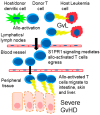Sphingosine 1-Phosphate Signaling and Its Pharmacological Modulation in Allogeneic Hematopoietic Stem Cell Transplantation
- PMID: 28934113
- PMCID: PMC5666709
- DOI: 10.3390/ijms18102027
Sphingosine 1-Phosphate Signaling and Its Pharmacological Modulation in Allogeneic Hematopoietic Stem Cell Transplantation
Abstract
Allogeneic haemopoietic stem cell transplantation (HSCT) is increasingly used to treat haematological malignant diseases via the graft-versus-leukaemia (GvL) or graft-versus-tumour effects. Although improvements in infectious disease prophylaxis, immunosuppressive treatments, supportive care, and molecular based tissue typing have contributed to enhanced outcomes, acute graft-versus-host disease and other transplant related complications still contribute to high mortality and significantly limit the more widespread use of HSCT. Sphingosine 1-phosphate (S1P) is a zwitterionic lysophospholipid that has been implicated as a crucial signaling regulator in many physiological and pathophysiological processes including multiple cell types such as macrophages, dendritic cells, T cells, T regulatory cells and endothelial cells. Recent data suggested important roles for S1P signaling in engraftment, graft-versus-host disease (GvHD), GvL and other processes that occur during and after HSCT. Based on such data, pharmacological intervention via S1P modulation may have the potential to improve patient outcome by regulating GvHD and enhancing engraftment while permitting effective GvL.
Keywords: sphingosine 1-phosphate, haemopoietic stem cell transplantation, graft-versus-host disease, graft versus leukaemia.
Conflict of interest statement
Philip Smith and Peter Gergely are employees of Novartis Institutes for BioMedical Research. Catherine O′Sullivan participated in an internship program offered by Trinity College Dublin and Novartis Institutes for BioMedical Research and was sponsored by Novartis.
Figures


Similar articles
-
The alliance of sphingosine-1-phosphate and its receptors in immunity.Nat Rev Immunol. 2008 Oct;8(10):753-63. doi: 10.1038/nri2400. Nat Rev Immunol. 2008. PMID: 18787560 Free PMC article. Review.
-
Separating graft-versus-leukemia from graft-versus-host disease in allogeneic hematopoietic stem cell transplantation.Immunotherapy. 2009 Jul;1(4):599-621. doi: 10.2217/imt.09.32. Immunotherapy. 2009. PMID: 20191089 Free PMC article. Review.
-
IFN-γ and indoleamine 2,3-dioxygenase signaling between donor dendritic cells and T cells regulates graft versus host and graft versus leukemia activity.Blood. 2012 Jan 26;119(4):1075-85. doi: 10.1182/blood-2010-12-322891. Epub 2011 Nov 30. Blood. 2012. PMID: 22130799 Free PMC article.
-
S1PR5 regulates NK cell responses in preventing graft-versus-host disease while preserving graft-versus-tumour activity in a murine allogeneic haematopoietic stem cell transplantation model.Hematol Oncol. 2020 Feb;38(1):89-102. doi: 10.1002/hon.2669. Epub 2019 Nov 26. Hematol Oncol. 2020. PMID: 31465552
-
Short Course of Post-Transplantation Cyclophosphamide and Bortezomib for Graft-versus-Host Disease Prevention after Allogeneic Peripheral Blood Stem Cell Transplantation Is Feasible and Yields Favorable Results: A Phase I Study.Biol Blood Marrow Transplant. 2015 Jul;21(7):1315-20. doi: 10.1016/j.bbmt.2015.02.008. Epub 2015 Mar 9. Biol Blood Marrow Transplant. 2015. PMID: 25765556 Clinical Trial.
Cited by
-
The Efficacy of Stem Cells in Wound Healing: A Systematic Review.Int J Mol Sci. 2024 Mar 5;25(5):3006. doi: 10.3390/ijms25053006. Int J Mol Sci. 2024. PMID: 38474251 Free PMC article.
-
Neutrophil CEACAM1 determines susceptibility to NETosis by regulating the S1PR2/S1PR3 axis in liver transplantation.J Clin Invest. 2023 Feb 1;133(3):e162940. doi: 10.1172/JCI162940. J Clin Invest. 2023. PMID: 36719377 Free PMC article.
-
The Enigma of Sphingolipids in Health and Disease.Int J Mol Sci. 2018 Oct 12;19(10):3126. doi: 10.3390/ijms19103126. Int J Mol Sci. 2018. PMID: 30321983 Free PMC article. No abstract available.
-
S1P/S1PR1 signaling differentially regulates the allogeneic response of CD4 and CD8 T cells by modulating mitochondrial fission.Cell Mol Immunol. 2022 Nov;19(11):1235-1250. doi: 10.1038/s41423-022-00921-x. Epub 2022 Sep 8. Cell Mol Immunol. 2022. PMID: 36071219 Free PMC article.
-
Graft-Versus-Host Disease Mouse Models: A Clinical-Translational Perspective.Methods Mol Biol. 2025;2907:1-56. doi: 10.1007/978-1-0716-4430-0_1. Methods Mol Biol. 2025. PMID: 40100591 Review.
References
-
- Ng Y.Y., Baert M.R., de Haas E.F., Pike-Overzet K., Staal F.J. Isolation of human and mouse hematopoietic stem cells. Methods Mol. Biol. 2009;506:13–21. - PubMed
Publication types
MeSH terms
Substances
LinkOut - more resources
Full Text Sources
Other Literature Sources

